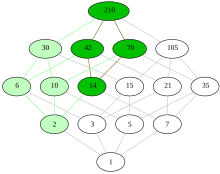
In the mathematical field of order theory, an ultrafilter on a given partially ordered set (or "poset") is a certain subset of namely a maximal filter on that is, a proper filter on that cannot be enlarged to a bigger proper filter on
If is an arbitrary set, its power set ordered by set inclusion, is always a Boolean algebra and hence a poset, and ultrafilters on are usually called ultrafilters on the set .[note 1] An ultrafilter on a set may be considered as a finitely additive 0-1-valued measure on . In this view, every subset of is either considered "almost everything" (has measure 1) or "almost nothing" (has measure 0), depending on whether it belongs to the given ultrafilter or not.[1]: §4
Ultrafilters have many applications in set theory, model theory, topology[2]: 186 and combinatorics.[3]
Cite error: There are <ref group=note> tags on this page, but the references will not show without a {{reflist|group=note}} template (see the help page).
- ^ Cite error: The named reference
Kruckman.2012was invoked but never defined (see the help page). - ^ Davey, B. A.; Priestley, H. A. (1990). Introduction to Lattices and Order. Cambridge Mathematical Textbooks. Cambridge University Press.
- ^ Goldbring, Isaac (2021). "Ultrafilter methods in combinatorics". Snapshots of Modern Mathematics from Oberwolfach. Marta Maggioni, Sophia Jahns. doi:10.14760/SNAP-2021-006-EN.






